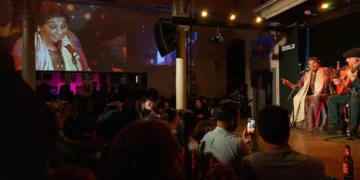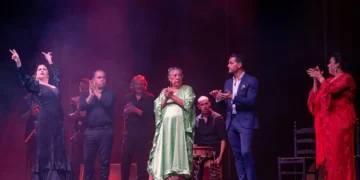|
XVI BIENAL DE FLAMENCO DE SEVILLA |
|||||||||||||||||
|
SPECIAL COVERAGE: BIENAL DE FLAMENCO DE SEVILLA 2010 «MUJEREZ» – Juana la del Pipa, Dolores Agujetas, Tomasa Guerrero 'La Macanita' Cante: Dolores Agujeta, Juana la del Pipa, “La Macanita”; Guitar: Moraíto, Diego de la Agujeta; Palmas, Jaleos and dance: Luisa Soto, Tía Curra, Bo, Chícharo Texto: Gonzalo Montaño Peña The show “Mujeres” was one of the most anticipated of the Bienal, sold out well in advance of the date. The art of the gypsy women of Jerez in its natural state was something no one wanted to miss. Everyone knew that if it came out well, it would be a memorable experience, something to tell the grandchildren about. The other day when I asked a colleague how he was faring with the Bienal, he answered that he was thinking of buying some pliers, and when I asked why, he said in order to pinch himself, the famous “pellizco” flamenco fans are always waiting for, because there wasn’t much “pellizco” happening during the shows. And I have to agree with him. Which is why last night’s show was something special, although it was no big deal, but with even the discreet offering, it made the whole night worthwhile because these women move in the landscape of emotion, and that’s what it’s all about. Last night there were small bursts, flashes of art and feeling, like when Juana la del Pipa sang bulería por soleá, struggling to find herself in the cante, pulling out those sounds from her raspy throat. Or seeing her raise her long arms in the air and stroll around the stage…that’s something that stays in the retina for a long time. Dolores Agujetas also had some excellent moments. We hoped for them in solea, but it didn’t happen, and there were brief snippets in siguiriyas, but they didn’t really go anyplace. We had to wait for the ronda of tonás for her ancient “echo” to bubble up to the surface touching every single person in the Teatro Lope de Vega; it made the wait more than worthwhile. Something similar happened with Tomasa Guerrero “La Macanita”, ups and downs, with the difference being that when this woman is up, we’re talking big-time flamenco, the capacity to move mountains. The sound and power of her prodigious voice can blow your socks off with just one “ayyy”, one line of soleá or bulerías… Last night she sang soleá and tonás with some unforgettable moments. This kind of show doesn’t tend towards consistency because it depends on the inspiration of the moment, not on rehearsal – improvisation rather than the quest for perfection. Because what you get is a moment of that certain special feeling, that vitality, instead of ninety minutes of competent correctness. Although within this unpredictable artistic ambience, special mention is due for guitarist Moraíto who is always terrific. «LA GLORIA DE MI MARE» – Choni Cía. Flamenca. Text: Estela Zatania Dance: Asunción Pérez “Choni”. Mother: Juanjo Macías. Don Cosme (empresario and guitarist): Raúl Cantizano. Doña Amalia (singer and wife): Alicia Acuña. Guest artist: Manuel Lombo. Choreography and artistic director: Asunción Pérez “Choni”. Choreography collaboration: Manuel Cañadas. Stage director: Estrella Távora. Compositions and music: Raúl Cantizano. One day Seville dancer Asunción Pérez “Choni” took a long slow look at the grey landscape of flamenco dance she was surrounded by, the false sophistication represented in numerous works by so many dancers of her generation. She then decided that to do away with the sometimes tacky image of flamenco from years past, it’s not necessary to resort to coldness or the absence of color. At least that’s what it looks like had to happen for this woman to be capable of creating “La Gloria de mi Mare”, a kind of wacky tribute to popular twentieth century Andalusian culture, before globalization transformed and standardized it. In this work there are plenty of polkadots and flowers, all the color, quick wit and surreal humor that characterizes this region, from the quips of the humblest waiter to the extravagant anecdotes Cádiz is famous for. But “La Gloria de mi Mare” isn’t buffoonery – there has always been more to Andalusian humor than meets the eye; an acerbic wit that manages the realities of life with charm and gusto. There is an emotional backdrop that’s not only nostalgia, but the dancer’s authentic love for this unique genre which is flamenco, and for a mother, the typical backstage mother yearning to make up for unfulfilled dreams by seeing them come to fruition in the daughter. It’s tricky making fun of clichés because you run the risk of becoming part of them. It takes a genius like the versatile showman and actor, Juanjo Macías, to identify and satirize the most humorous aspects of daily life that seem so normal to us. In the great tradition of Spain’s best comic actors such as Martínez Soria, Landa or Fernán-Gómez, the genius of Macías is the driving-force that makes this show, created and interpreted by Choni, possible. As a dancer, she is discreetly competent, accurately representing the Seville school. However, the most admirable element is not her dancing, but her imagination and personality, a creative capacity that even manages to find humor in the middle of a siguiriya. In addition to the siguiriya, there is caña, alegrías and Niña de Fuego among other numbers, but always as part of the basic plot of dancer + mother + businessman (played by guitarist Raúl Cantizano who demonstrates his acting ability) + businessman’s wife (Alicia Acuña, equally surprising as the plump singer who also dances and does some credible acting). The simple but ingenious staging, good sound and the exuberance and capacity of the interpreters make “La Gloria de mi Mare” a little jewel of flamenco theater. Pity it can’t be translated or adapted for other languages and cultures. «RAIMUNDO AMADOR + REMEDIOS AMAYA/LA MALA» Raimundo Amador At some point in the past, Raimundo stopped catching my interest, but that’s not how it was in the beginning. I used to think he was wonderful during that time when he teamed up with his brother Rafael in Pata Negra. They had “essence”, the feel of the ‘hood, the gypsy guitar of the Amador brothers, Jimi Hendrix played falsetas of Diego del Gastor and it all came out as musical rebellion. The recording “Guitarras Callejeras” is memorable, and the same could be said of “Inspiración y Locura” or his “Rock Gitano” (a young Juan José Amador one day confessed to me that he couldn’t understand what his cousins were up to in those days, and it all seemed crazy), high-quality works. However, the more recent era of Raimundo, playing on his own, really puts me to sleep. He doesn’t seem to have anything to say, he’s become bourgeois or maybe just hasn’t found anything he considers worth presenting. Last night he gave a preview of his upcoming work and also reprised some of the best-known themes of his solo career, things like “Ay, qué gustito pa’ mis orejas” and “Bolleré”. There was also the added luster of some guest artists like Remedios Amaya, Diego Amador and rapper Junior. Mala Rodríguez Last night Mala surprised me with the band she brought. I had been expecting a DJ, a chorus and the artist herself, the typical rapper formation, so it was surprising to see no DJ, and no canned sound at all. It was a band made up of drums, bass, guitar, chorus and Mala María showing that she’s enough of a singer and has a big enough personality to be outstanding in live performance. As a rapper, Mala Rodríguez seems to be one of the few interesting interpreters on the current scene. But anyone trying to fit her into some kind of flamenco mold is mistaken, because I don’t find anything flamenco in her or her recordings. She has the Andalusian wit, but flamenco almost nothing, or nothing. Flamenco rap is something else, and it existed before anyone even knew the word, in phrases of Tío Borrico in bulerías, or even martinete, or other geniuses like Diego Carrasco; that’s rap, speaking in compás. Mala’s themes sometimes have a kind of flow or “soniquete” as they say in flamenco, and in her most recent work she has a polished sound with good production and daring, well-written lyrics. Last night the singer let loose all her power, even moments of insolence within her stage persona of young girl from the other side of the tracks. I think she drew more people than Raimundo and they had a fine time, more than sufficient justification for this program. «4 ASES DEL FLAMENCO 4». Text: Estela Zatania Anyone of a certain age can’t help but remember that series of recordings “Los Ases del Flamenco”, ‘flamenco aces’, in which flamenco fans able to afford it (a minority), could enjoy the biggest stars of flamenco singing of the era. From the countless “Niños” specialized in fandangos, Cojo de Málaga, Carbonerillo and Pena Hijo, to Chacón or Pastora and Tomás Pavón among so many others. The title of this show, “4 Ases del Flamenco” situates us in that time-frame of “pre-fusion” flamenco (a term that avoids the use of other more controversial ones such as “classic”, “traditional” or “pure”) whose protection and conservation is the responsibility of the Confederation of Flamenco Clubs of Andalusia. This particular event of the 1st Encounter of Peñas Flamencas of Andalusia was included within the program of the Bienal de Flamenco de Sevilla, filling the autumn evening with flamenco singing and dance at the Hotel Triana. The setting of the old patio couldn’t have been more appropriate for the program of four singers, the “aces”, who at one time or another had been winners of the contest put on by the Confederation, along with dancer Carmen Ledesma and her group. Singer Bonelo Hijo, with Andrés Cansino on guitar, sang forms from his native Málaga with the authentic flavor that comes from one’s hometown, soleá apolá recalling the late Chino de Málaga and bulerías. Paco Moya gave his best Mairena-style livianas and toná liviana with the ending of María Borrico and marianas. Joselete de Linares was noteworthy in soleá; at fifty-something he is a singer deserving of more attention. El Polaco, from Granada despite the nickname, paid tribute to Caracol with his interpretation of “Carcelero”, and to Enrique Morente with the popular song “Estrella”. Carmen Ledesma, with Antonio Moya on guitar, treated us to her particular rustic elegance, taking inspiration from the voices of Mari Peña and Herminia Borja, and the laidback compás that so enhances this dancer’s sedate style. |
Descubre más desde Revista DeFlamenco.com
Suscríbete y recibe las últimas entradas en tu correo electrónico.











































